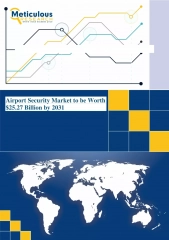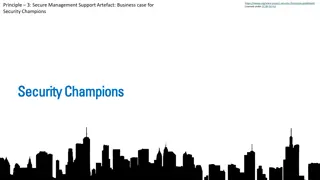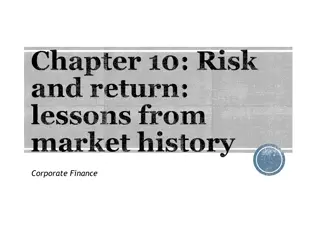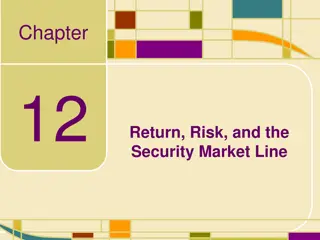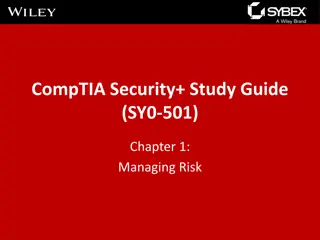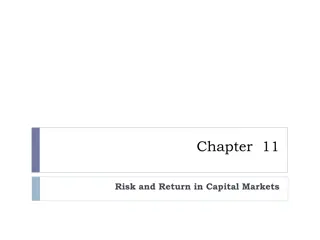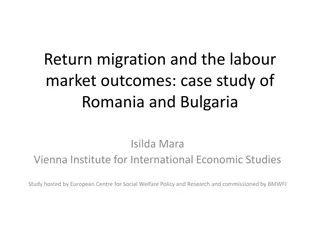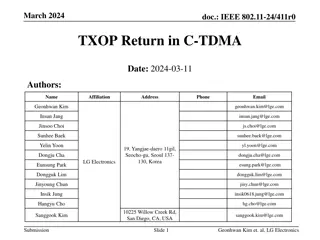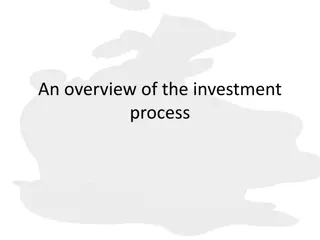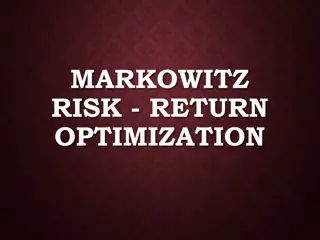Understanding Risk and Return in the Security Market
Expand your knowledge on risk and return within the security market. Learn how to define, measure, and quantify risk, as well as analyze expected returns and variances for individual assets. See how different economic states can affect stock returns and explore the concept of risk premium.
Download Presentation

Please find below an Image/Link to download the presentation.
The content on the website is provided AS IS for your information and personal use only. It may not be sold, licensed, or shared on other websites without obtaining consent from the author. Download presentation by click this link. If you encounter any issues during the download, it is possible that the publisher has removed the file from their server.
E N D
Presentation Transcript
+ RETURN, RISK, AND THE SECURITY MARKET LINE Ch 13
+ we have concentrated mainly on the return behavior of a few large portfolios. We need to expand our consideration to include individual assets. Specifically, we have two tasks to accomplish. First, we have to define risk and discuss how to measure it. 1. We then must quantify the relationship between an asset s risk and its required return. 2.
+ 13.1 Expected Returns and Variances how to analyze returns and variances when the information we have concerns future possible returns and their probabilities.
+EXPECTED RETURN straightforward case, Consider a single period of time say a year. We have two stocks, L and U, which have the following characteristics: Stock L is expected to have a return of 25 percent in the coming year. Stock U is expected to have a return of 20 percent for the same period. In a situation like this, if all investors agreed on the expected returns, why would anyone want to hold Stock U? After all, why invest in one stock when the expectation is that another will do better? the answer must depend on the risk of the two investments. The return on Stock L, although it is expected to be 25 percent, could actually turn out to be higher or lower.
+ For example, suppose the economy booms. In this case, we think Stock L will have a 70 percent return. If the economy enters a recession, we think the return will be ? 20 percent. In this case, we say that there are two states of the economy, which means that these are the only two possible situations.
+ Suppose we think a boom and a recession are equally likely to happen, for a 50 50 chance of each. Table 13.1 illustrates the basic information we have described and some additional information about Stock U. Notice that Stock U earns 30 percent if there is a recession and 10 percent if there is a boom. E(RU)=(0.5*0.3)+(0.5*0.10)=20% E(RL)=(0.5*-0.20)+(0.5*0.70)=25% State of Economy Probability of State of Economy Rate of Return if State Occurs Stock L Stock U Recession 0.50 ? 20% 30% Boom 0.50 70% 10%
+ Stock L Stock U (1) (2) (3) (4) (5) (6) State of Economy Probabilit y of State of Economy Rate of Return if State Occurs Product (2)*(3) Rate of Return if State Occurs Product (2)*(5) Recession 0.50 -0.2 -0.1 0.30 0.15 Boom 0.50 0.70 0.35 0.10 0.05 1 E(RL)=25% E(RU)=20%
+ If the risk free rate is 8% Risk premium=Expected return-Risk-free rate =E(RU)-Rf =20%-8% =12% And =E(RL)-Rf =25%-8% =17%
+CALCULATING THE VARIANCE To calculate the variances of the returns on our two stocks, we first determine the squared deviations from the expected return. We then multiply each possible squared deviation by its probability. Variance= 2=? 0.5*(0.10)2+0.5*(-0.10%)2=0.01 Standard deviation= square root of the variance = 0.01= 0.1=10% Stock L 25% .2025 45% Stock U 20% .0100 10% Expected return E(R) Variance 2 Standard deviation
+ (1) (2) (3) (4) (5) State of Economy Probability of State of Economy Return Squared Return Deviation from Expected Return Product (2)*(4) Deviation from Expected Return Stock L Recession .50 -0.20-0.25=-0.45 -0.452 .10125 Boom .50 0.70-0,25=0.45 0.452 .10125 L2=.20250 Stock U Recession Boom .50 .50 0.30-0.20=0.10 0.10-0.20=-0.10 0.102 0.102 .005 .005 U2=.010
+13.2 Portfolios Portfolio :a group of assets such as stocks and bonds held by an investor. we have concentrated on individual assets considered separately. However, most investors actually hold a portfolio of assets. (1) (2) Probability of State of Economy (3) (4) State of Economy Portfolio Return if State Occurs Product (2)*(3) Recession Boom 0.50 0.50 0.50*-20%+0.50*30%=5% 0.50*70%+0.50*10%=40 % .025 .200 E(RP)=22.5%
+PORTFOLIO WEIGHTS portfolio weight: the percentage of a portfolio s total value that is in a particular asset. For example, if we have $50 in one asset and $150 in another, our total portfolio is worth $200. The percentage of our portfolio in the first asset is $50? $200 ? centage of our portfolio in the second asset is $150? $200, or .75. Our portfolio weights are thus .25 and .75. Notice that the weights have to add up to 1.00 .25. The per-
+PORTFOLIO EXPECTED RETURNS Let s go back to Stocks L and U. You put half your money in each. The portfolio weights are obviously .50 and .50. What is the pattern of returns on this portfolio? In a recession Rp=0.50*-20%+0.50*30%=5% when a boom occurs Rp=0.50*70%+0.50*10%=40% E(Rp)=0.50*E(RL)+0.50*E(RU) =0.5-*35%+0.50*20%=22.5% E(Rp)=X1*E(R1)+X2*E(R2)+ Xn*E(Rn)
+PORTFOLIO VARIANCE the expected return on a portfolio that contains equal investments in Stocks U and L is 22.5 percent. What is the standard deviation of return on this portfolio? p=0.50*45%+0.50*10%=27.5% Suppose we put 2? 11 (about 18 percent) in L and the other 9? 11 (about 82 percent) in U. If a recession occurs, this portfolio will have a return of: RP=(2/11)*-20%+(8/11)*30%=20.91%
(1) (2) (3) (4) (5) + Economy State of Probabili ty of State of Economy Return Deviation from Expected Return 5% 40% Squared Return Deviation from Expected Return Product (2)*(4) Recession Boom 0.50 0.50 (0.05-0,225)2=.030625 (0.40-0,225)2=.030625 .0153125 .0153125 P2=.030625 P= .030625 =17.5% If a boom occurs, this portfolio will have a return of: RP=(1/11)*70%+(8/11)*10%=20.91%


